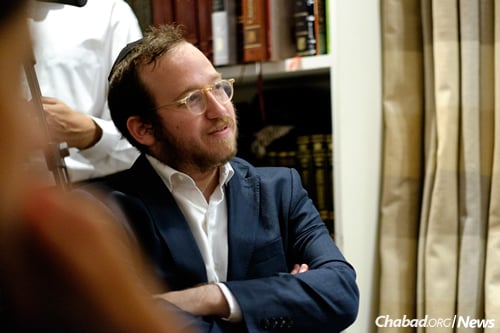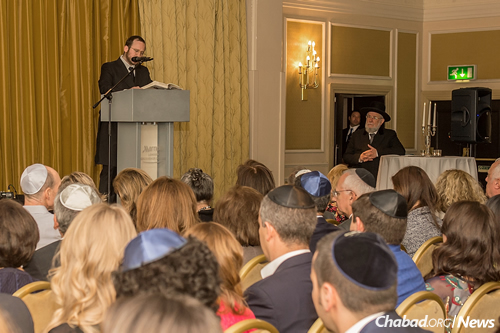
“A hallmark of the Rebbe’s [Rabbi Menachem M. Schneerson, of righteous memory] approach to the world was an almost stubborn optimism in the face of tragedy—a refusal to live in fear or to see our world as anything but inherently good,” writes Rabbi Mendel Kalmenson in his new book, “A Time to Heal: The Lubavitcher Rebbe’s Response to Loss and Tragedy.”
In this important and timely work, Kalmenson explores numerous instances throughout the Rebbe’s decades of leadership where the Rebbe offered insight and consolation to individuals and communities in their greatest moments of need.
Kalmenson, rabbi and executive director of Chabad of Belgravia in London, England, took time to discuss “A Time to Heal” and the reasons for writing it.
Q: Coping with death and tragedy are subjects that people deal with and rabbis counsel about every day, yet they are not generally part of the yeshivah curriculum, and are not topics that people usually delve into willingly before tragedy strikes. What sparked your interest to research and write about the topic in such depth?
A: I actually never set out to write a book about loss and tragedy. I was working as an editor at Chabad.org during a particularly painful time for the Jewish community, when a number of tragedies transpired one after another, including the horrific murder of the Fogel family in Itamar, Israel, and the kidnapping and dismembering in Brooklyn of a young boy named Leiby Kletzky on the first day that his parents allowed him to walk home alone from day camp, among others. These touched me very deeply. It’s interesting how different tragedies touch people in different ways, and while as Jews we are taught to empathize and take the pain of others personally, it’s emotionally draining to always be open to other people’s pain.
For whatever reason, I took these incidents personally, and found myself trying to formulate a reflection and response that could somehow address or at least alleviate the pain that often results from encountering suffering and tragedy. One article turned into two, and then three, and before long, they expanded over the years and formed the basis for A Time to Heal.

Q: How is the Rebbe’s approach to loss and mourning different than that presented in other works on the subject? What does this book add to the conversation?
A: While researching some of the classical Jewish literature on the subject, I realized that, to generalize a bit, there were two categories: the more theoretical approach, which dealt with the topic detachedly, employing intellectual language and tools to plumb the philosophical and theological issues, but are arguably somewhat inaccessible to someone experiencing the profound emotional turmoil and trauma of grief; and then there was material that went to the other extreme, creating space for the expression of pain, but sometimes at the expense of some of the fundamental principles of faith.
What made the Rebbe’s approach so unique to me was that in his correspondence and interactions with people seeking his comfort and counsel, he always managed to fuse his staunch faith in the ways of G‑d Almighty with his profound love and empathy for humanity. He is unapologetic when it comes to communicating the principles of Jewish faith that are sometimes hard to digest, and yet does so in a manner and tone that convey his profound compassion and understanding of the very raw and real pain that those with whom he was communicating were undergoing.
To quote, if I may, from my introduction: “In the Rebbe’s correspondence with the bereaved, there is both an insistence that all events are part of a Divine plan and that everything happens for the best, as well as a very real acceptance of human suffering and its expression. In the Rebbe’s worldview, expressions of faith and expressions of human vulnerabilities are not contradictory. Gratitude for the life that was can find expression alongside grief, and unwavering faith can coexist even with a challenge to G‑d’s ways.”
In order to capture the unique balance the Rebbe wove between the philosophical and the emotional, between the principles of Jewish mourning and their practice, I chose in the book to frame the Rebbe’s actual words—whether excerpted from letters, private interactions or public talks—within as much of a storyline as possible. Instead of simply providing the reader with a collection of the Rebbe’s texts on the topic of loss, I thought that it’s also important to present the human context that the Rebbe was addressing. So the format comprises personal stories of those who have suffered loss and the Rebbe’s compassionate responses to them.
In this way, I hoped to bring alive the manner in which the Rebbe applied the teachings of Torah and chassidus to bring healing and hope to so many.
Q: There are many causes and types of loss and mourning, and the Rebbe’s responses to the individuals involved were unique to each situation. Can you identify some specific themes that guided the Rebbe’s approach overall?
A: Definitely. I would summarize those themes into: faith, spiritualism and action.
“Faith” is the belief that everything comes from G‑d, whether we understand His reasoning or not, and consequently, the faith that a person only leaves this physical life and existence when G‑d chooses to call him or her back.
By “Spiritualism” I mean that the “realness” of reality is the spiritual content inside everything that exists, including the human being. Put differently, we are not physical beings having a spiritual experience; we are spiritual beings having a physical experience. In other words, the real “me” or “you”—i.e., the meaningful aspect of our existence—and the part in each other that we really connect to and love is not the physical shell or “vessel” of our bodies, but the spirit, personality, character or soul within us all. And that part of us is eternal.
“Action”: In the Rebbe’s counsel, there was a constant emphasis on constructive action. The Rebbe’s message was that while Judaism does not rationalize or justify tragedy, it does have a response (hence, the subtitle for the book, The Rebbe’s Response to Loss and Tragedy). Instead of asking “Why Me?” we are redirected to ask “What Now?” We’ve all seen how the painful energy created by tragedy can remain inside a person and fester, sucking the joy out of life and perhaps even boiling over in unhealthy release. The Rebbe would instead gently and lovingly channel their experience to animate and fuel a positive initiative or cause.

Q: Your book appears to focus a lot on the balance between having faith and questioning G‑d. Can you provide an example from the book of how the Rebbe struck that delicate balance?
A: In my mind, without a doubt, the Rebbe’s response to the murder of Mrs. Pesha Leah Lapine (see Chapter 28: The Believer’s Outcry) is a most powerful example of the very delicate and sensitive balance the Rebbe negotiated between unflinching faith and a heartrending “challenge” to G‑d Almighty to bring an end to all pain and suffering through the coming of Moshiach.
Q: When it comes down to it, who is the book really written for?
A: Thank you for asking. Of course, the book contains a great deal for those who’ve actually experienced loss, G‑d forbid, and are grieving. It also provides much food for thought and discussion to those who want to help a friend or loved one who is suffering. But it also has relevance and urgency for people living in Israel who are undergoing a terrifying new wave of violence and terror, as well as the many of us in deep pain about what our brothers and sisters in Israel are enduring.
Based on some of the early feedback I’ve gotten, it appears that many in the mental-health community can find new insight from the Rebbe’s words as well. Now, more than ever, the Rebbe’s message of hope and optimism (Chapter 20), of faith in the supremacy of good over evil (Chapter 21), of the tangible effect of positive thinking (Chapter 13) and the protective power of mitzvot (Chapter 24) are especially pertinent.
It is my fervent hope and prayer that in the very near future, when pain and suffering will be eradicated, and the intrinsic goodness within the world be revealed with the coming of Moshiach (May it be speedily in our day!), this book will be relegated to more theoretical and academic realms.
Until then however, I believe the audience for this book is very, very broad. It is a truism that nowadays, we all know someone within only a degree or two away from ourselves undergoing great pain and hardship. I think we can all benefit greatly from the Rebbe’s sage counsel, to guide and heal us, and to help spread healing to others.
May true healing arrive to this world speedily in our days!
“A Time to Heal: The Lubavitcher Rebbe’s Response to Loss and Tragedy”—a collaboration between Chabad.org and Ezra Press, an imprint of the Kehot Publication Society—is available for purchase here.





